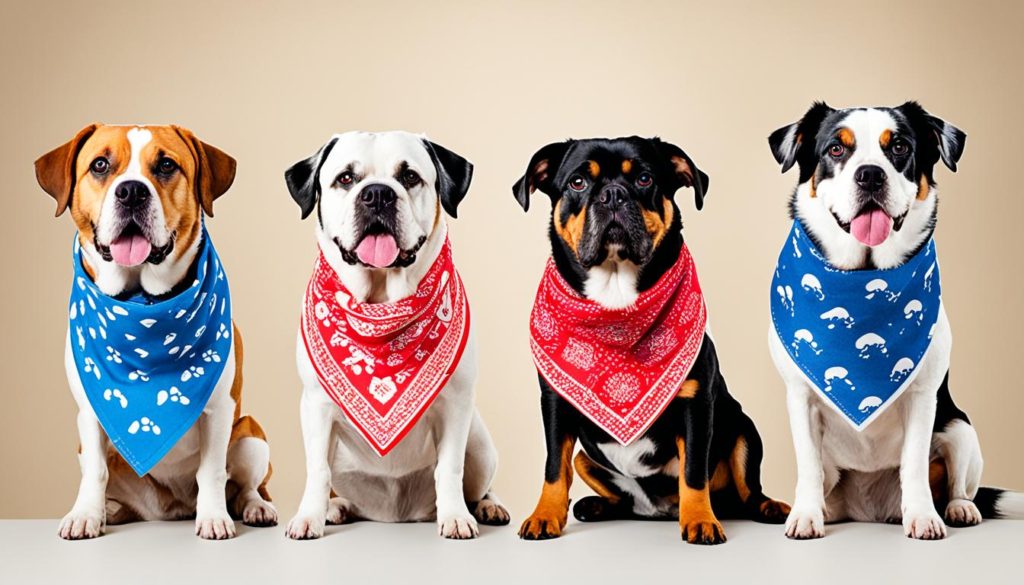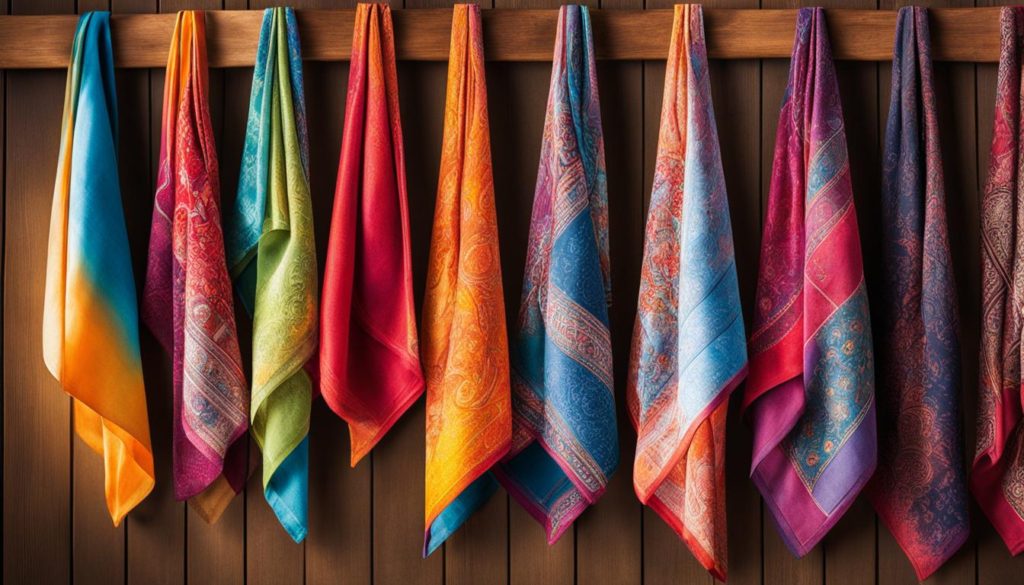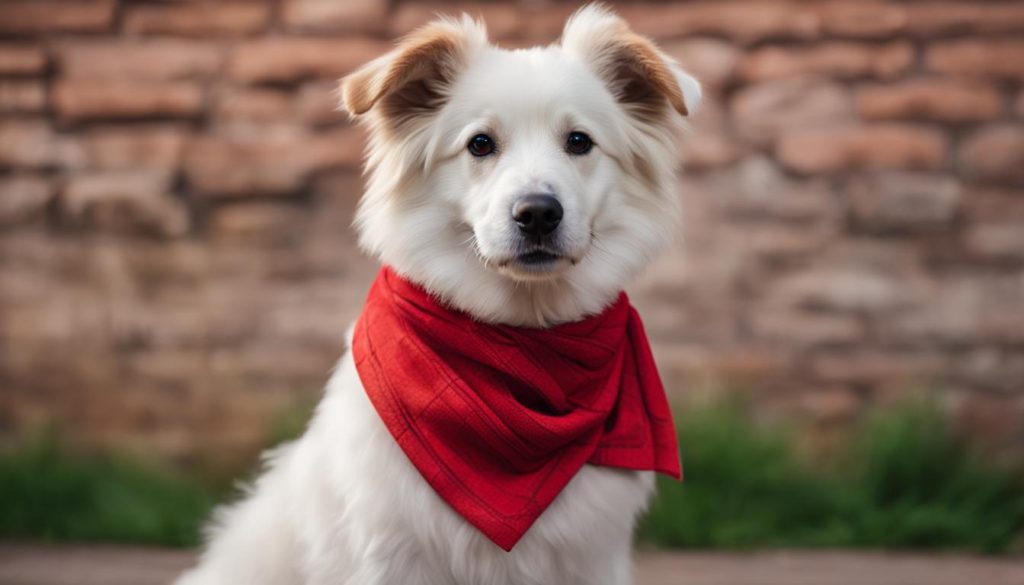Putting a bandana on a dog is a stylish and fashionable way to accentuate your pet’s individuality. There are multiple ways to tie a bandana, each offering a different look for your furry friend. Whether you want your dog to look like a cowboy or prefer a more minimalistic approach, we’ve got you covered. In this guide, we will show you step by step how to put a bandana on a dog and why it is a versatile accessory for both fashion and functionality.
Bandanas are not only trendy but also serve as a useful tool for bandana dog training. By incorporating a bandana into your pup’s wardrobe, you can provide them with a stylish and comfortable accessory that can contribute to their overall well-being.
Key Takeaways:
- Putting a bandana on a dog is a stylish way to showcase their personality.
- There are different ways to tie a bandana on a dog, allowing for customization.
- Choosing the right size and style is essential for a comfortable fit.
- Ensure your dog’s safety by tying the bandana loosely.
- The color of the bandana can have specific meanings or convey messages.
Different Ways to Tie a Bandana on a Dog
There are various ways to tie a bandana on a dog, allowing you to customize the look to suit your pet’s style. Some popular methods include the cowboy knot, basic roll tie, cape-style, and the over the collar bandana. Each method offers its own unique aesthetic and can be easily achieved with a few simple steps. Get creative and experiment with different tying techniques to find the one that suits your pup best.
Take a look at the step-by-step instructions below:
- Cowboy Knot: Fold the bandana into a triangle shape. Place the center of the bandana on the front of your dog’s neck, with the point of the triangle facing down. Cross the ends of the bandana under your dog’s neck and tie them in a knot on the side. Adjust the bandana to create a fashionable cowboy look.
- Basic Roll Tie: Roll the bandana diagonally from the corner to the opposite edge to create a long strip. Place the center of the strip on your dog’s neck, letting the ends hang down evenly. Tie a knot to secure the bandana in place, making sure it is not too tight. This classic style is simple yet stylish.
- Cape-Style: Fold the bandana into a triangle shape. Position the center of the bandana on the back of your dog’s neck, with the point of the triangle facing towards the tail. Cross the ends of the bandana under the belly and tie them in a knot on top of the back. This method gives your dog a trendy cape-like appearance.
- Over the Collar Bandana: Choose a bandana that can be easily slipped over your dog’s collar. Slide the collar through the bandana, ensuring it sits securely. Adjust the bandana as necessary to achieve the desired look. This method is convenient and avoids any knots or ties.
Remember to consider your dog’s comfort and safety when tying a bandana. Ensure that it is not too tight or restrictive, allowing your furry friend to move and play freely.
Choosing the Right Bandana Size and Style
When it comes to dressing up your furry companion in a bandana, finding the right size is key for a comfortable fit. You want your dog to look adorable and stylish, but it’s important to ensure that the bandana doesn’t restrict their movement or cause any discomfort.
To determine the right size bandana for your dog, start by measuring their neck in the widest part. Use this measurement as a guide when purchasing a bandana, making sure to consider the size chart provided by the brand or retailer.
A properly fitted bandana should be snug enough to stay in place without sliding off, but not too tight that it restricts your dog’s movement or causes any discomfort. Remember, their safety and comfort should always be the top priority when choosing a bandana.
While the size is important, let’s not forget about the style! Dog bandanas come in a wide range of styles, patterns, and colors to suit your pup’s personality. From cute and playful prints to sophisticated and elegant designs, there’s a bandana style for every dog.
Popular Dog Bandana Styles
- Casual and Classic: Simple patterns and solid colors for a timeless look.
- Fun and Whimsical: Playful prints and vibrant colors to showcase your dog’s playful side.
- Sporty and Athletic: Bandanas featuring sports motifs or team logos for the sporty pups.
- Elegant and Formal: Fancy fabrics and stylish designs for special occasions.
Remember, the right bandana size and style can truly make your dog stand out in any crowd. So, measure your pup’s neck, browse through the various styles, and choose a bandana that not only fits well but also reflects their unique personality.

Safety Tips for Tying a Dog Bandana
While bandanas can be a stylish accessory for your dog, it’s important to prioritize their safety and comfort. When tying a dog bandana, follow these safety tips to ensure a comfortable fit for your furry friend:
- Loosely tie the bandana: It’s crucial to tie the bandana loosely around your dog’s neck to avoid any discomfort or restriction of movement. The bandana should have enough space between the fabric and your dog’s neck to ensure a comfortable fit.
- Choose the right size: Ensure that the bandana is the correct size for your dog. Measure your dog’s neck in the widest part and use this measurement as a guide when purchasing a bandana. The bandana should fit snugly enough to stay in place but not too tight to restrict movement.
Remember, safety should always be the top priority when dressing up your dog with a bandana!
| Benefit | Explanation |
|---|---|
| Comfortable Fit | Tying the bandana loosely ensures a comfortable fit for your dog, preventing any discomfort or restriction of movement. |
| Free Breathing | A properly tied bandana allows your dog to breathe freely, avoiding any breathing difficulties that could arise from a tight fit. |
| Easy Removal | A loosely tied bandana can be easily removed by your dog if they feel uncomfortable or need to be freed from it. |
By following these safety tips, you can ensure that your dog not only looks stylish but also remains safe and comfortable while wearing a bandana.
The Role of Color in Dog Bandanas
Dog bandanas come in a variety of colors, and each color can have a specific meaning or significance. The color of a dog’s bandana can communicate valuable information to others, allowing for better understanding and interactions. Here are some common colors of dog bandanas and their potential interpretations:
Green Bandanas
A green bandana may indicate that your dog is friendly and approachable. It serves as a signal to other people and dogs that your pet is open to socialization and positive interactions. If your dog wears a green bandana, it can help create a welcoming atmosphere during outings at the park or other social events.
Yellow Bandanas
A yellow bandana on a dog can signify that your furry friend requires extra space or is in training. This color serves as a visual cue to others that your dog may need some distance or patience. It can be particularly useful if your dog is working on specific behavior training or has certain sensitivities that require understanding and respect from others.
Red Bandanas
On the other hand, a red bandana may signal that your dog is not comfortable with interactions. It can indicate that your pet needs space and should not be approached by strangers or unfamiliar dogs. A red bandana can be particularly helpful if your dog is anxious, reactive, or in need of some downtime during outings.
It’s important to note that the significance of dog bandana colors can vary, and not all interpretations are universally understood. However, using these color cues can provide valuable information and help facilitate positive and respectful interactions between dogs and their owners.

Additional Uses and Benefits of Dog Bandanas
Dog bandanas are not just a fashion statement for your furry companion; they also serve practical purposes. With their versatility, you can use dog bandanas in various ways to enhance your pet’s comfort and safety.
1. Cooling Relief on Hot Days
During scorching summer days, you can help your dog stay cool by using a bandana soaked in a cooling spray. Simply wet the bandana, wring out the excess water, and tie it loosely around your dog’s neck. The evaporative cooling effect can provide much-needed comfort and help regulate your dog’s body temperature.
2. Increased Visibility during Nighttime Walks
If you enjoy taking your dog for walks during the evening hours, a fluorescent bandana can be a practical accessory. The bright color enhances your dog’s visibility, making them more noticeable to passing vehicles and pedestrians. This added safety feature can give you peace of mind during nighttime outings.
As you can see, dog bandanas have multiple uses and benefits beyond their stylish appearance. Whether it’s providing cooling relief or promoting visibility, these accessories can enhance your dog’s well-being and safety in various situations.
Conclusion
Putting a bandana on your dog is not just a fashion statement but also a way to express their unique personality. By following our step-by-step guide and trying out different tying techniques, you can find the perfect bandana style that suits your furry friend. Remember to prioritize safety and comfort by choosing the right size and color for your dog.
Bandanas offer more than just style; they also have practical applications. You can use a bandana soaked in a cooling spray to provide relief on hot days or choose a fluorescent bandana to enhance visibility during nighttime walks. So, put a bandana on your dog today and elevate their style while enjoying the many benefits it brings.
In conclusion, bandanas can transform your dog’s appearance, making them look fashionable and trendy. Embrace the versatility of dog bandanas and have fun exploring all the different styles. Enhance your dog’s fashion game and showcase their individuality with a well-tied bandana. So why wait? Start experimenting with bandana tying techniques and treat your dog to a stylish accessory that they’ll surely love!
FAQ
How do I put a bandana on my dog?
To put a bandana on your dog, follow these steps: 1) Fold the bandana into a triangle, then roll it tightly from the widest end to the opposite point. 2) Place the rolled bandana around your dog’s neck, with the triangle pointing down. 3) Cross the ends of the bandana under your dog’s chin and bring them to the back of the neck. 4) Tie a double knot to secure the bandana in place. Adjust as needed for comfort.
What are the different ways to tie a bandana on a dog?
There are several ways to tie a bandana on a dog: the cowboy knot, basic roll tie, cape-style, and over the collar bandana. Each method offers a unique look and can be achieved with a few simple steps. Feel free to experiment and find the style that suits your furry friend best.
How do I choose the right size bandana for my dog?
Measure your dog’s neck in the widest part and use this measurement as a guide when purchasing a bandana. It should fit snugly enough to stay in place but not too tight to restrict movement.
Are there any safety tips for tying a dog bandana?
Yes, when tying a bandana on your dog, make sure to tie it loosely to allow space between the fabric and your dog’s neck. This ensures a comfortable fit and prevents any discomfort or restriction of movement. Always prioritize your dog’s safety and well-being.
What is the significance of dog bandana colors?
Dog bandanas come in various colors, and each color can have a specific meaning or significance. For example, a green bandana may indicate that your dog is friendly and approachable, while a yellow bandana can signify that your dog requires extra space or is in training. A red bandana may signal that your dog is not comfortable with interactions. Choose a color that suits your dog’s personality and needs.
Are there any other uses and benefits of dog bandanas?
Yes, dog bandanas offer more than just a fashion statement. You can use a bandana soaked in a cooling spray to provide relief for your dog on hot days. A fluorescent bandana can also increase your dog’s visibility during nighttime walks. Additionally, bandanas can be a practical accessory to keep your dog’s neck warm in colder weather.
